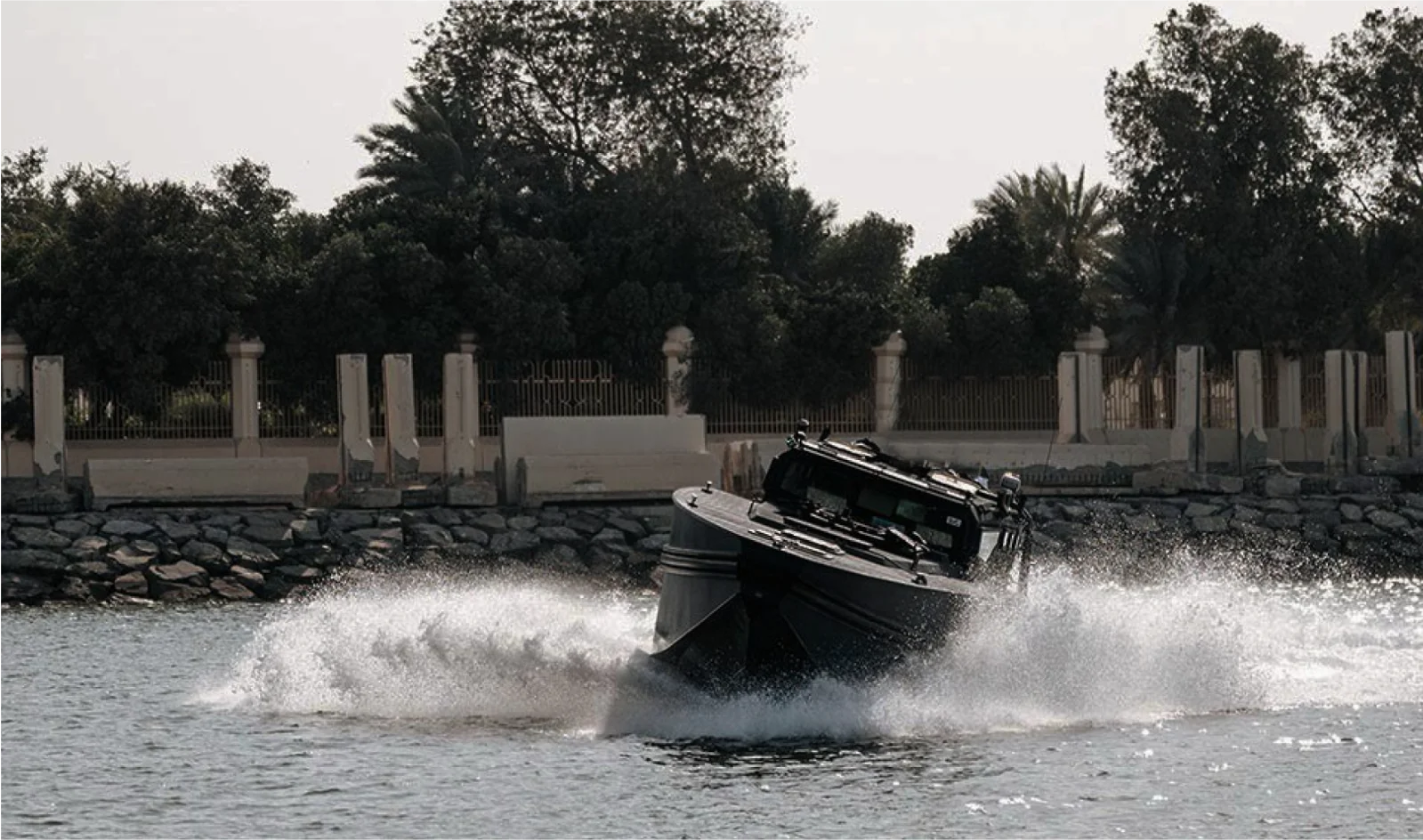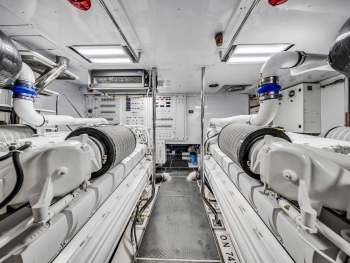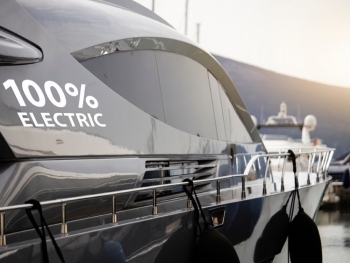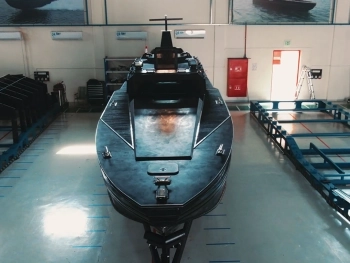For decades, fiberglass has been the unquestioned standard in yacht and boat construction. Lightweight, affordable, and easy to mold, it revolutionized the industry in the mid-20th century - replacing wood and steel as the go-to material for pleasure craft.
But innovation never sleeps. In recent years, polyethylene (HDPE) - a durable, recyclable plastic better known for use in industrial and military vessels - has begun making waves in the world of luxury yachting.
Builders like Perulla are at the forefront of this change, pioneering polyethylene hull designs that challenge traditional assumptions about how yachts should be built.
So, what makes these two materials different? And could polyethylene really be the future of yacht construction?
Let’s explore.
1. Fiberglass: The Traditional Standard
1.1 What Is Fiberglass?
Fiberglass (also called GRP, or glass-reinforced plastic) is a composite material made by embedding strands of glass fiber into a resin matrix - usually polyester or epoxy. When cured, it forms a lightweight yet strong shell.
Since the 1950s, fiberglass has dominated yacht construction because it offers the ideal combination of:
- Moldability – easily shaped into complex curves and sleek designs
- Low Maintenance – unlike wood, it doesn’t rot or corrode
- Affordability – cost-effective to produce in volume
- Smooth Finish – ideal for high-end yacht aesthetics
1.2 Advantages of Fiberglass Hulls
✅ Proven track record - decades of service across all vessel types
✅ Lightweight and efficient for high-speed designs
✅ Sleek finish allows for advanced hydrodynamics
✅ Easy to repair with composites
1.3 Limitations of Fiberglass
⚠️ Brittleness under impact - can crack or delaminate if struck
⚠️ Difficult recycling - composite waste is often non-recyclable
⚠️ Water absorption - “osmosis” (blistering) can occur over time
⚠️ Structural fatigue - prolonged stress can lead to micro-fractures
In short: fiberglass is proven and versatile, but not indestructible.
2. Polyethylene (HDPE): The Modern Challenger
2.1 What Is Polyethylene?
High-density polyethylene (HDPE) is a thermoplastic polymer - flexible, strong, and resistant to impact, chemicals, and UV exposure. Historically used for workboats, patrol vessels, and rescue craft, it’s now entering luxury yacht design.
Builders like Perulla have pushed HDPE’s potential further, refining welding techniques and surface finishing to create hulls that are not only tough but visually refined - a combination once thought impossible.
2.2 Advantages of Polyethylene Hulls
✅ Extreme impact resistance - virtually unbreakable in collisions or grounding
✅ Non-corrosive & non-porous - zero risk of osmosis or rot
✅ Flexibility under stress - absorbs impact rather than cracking
✅ UV-resistant and long-lasting, even in tropical climates
✅ Recyclable - can be reprocessed at end of life
✅ Low maintenance - no painting or waxing required
2.3 Engineering Innovations
Perulla’s research and development efforts have introduced key technical advances in polyethylene yacht design:
- Double-sided extruder welding for stronger joints
- T-joint welding standards improving hull-to-deck integrity
- Custom surface texturing and paint bonding for refined finishes
- Integrated structural reinforcement using internal rib systems
These innovations have turned HDPE from a rugged utility material into a viable, premium construction option for long-life yachts.
3. Performance Comparison: Fiberglass vs. Polyethylene
| Feature | Fiberglass (GRP) | Polyethylene (HDPE) |
|---|---|---|
| Weight | Light | Slightly heavier, depends on density |
| Impact Resistance | Moderate – can crack or delaminate | Exceptional – flexes, doesn’t crack |
| Durability | 20–30 years typical | 50+ years with minimal maintenance |
| Maintenance | Requires polishing, gelcoat care | Minimal – naturally smooth, no coating |
| Repairability | Requires composite resins | Easy heat-weld repairs |
| Corrosion Resistance | High | 100% immune |
| Recyclability | Poor | Excellent – fully recyclable |
| Cost | Moderate | Slightly higher upfront, lower lifetime cost |
| Noise/Vibration Dampening | Moderate | Excellent – material absorbs sound |
| Aesthetics | Smooth gelcoat finish | Textured or painted finishes (improving fast) |
4. Performance on the Water
4.1 Ride Comfort
HDPE’s natural flexibility acts as a shock absorber, softening the ride in chop or when planing through waves.
Fiberglass hulls are stiffer - giving sharper handling but transmitting more vibration.
4.2 Fuel Efficiency
Because HDPE hulls are heavier, fuel consumption can be slightly higher.
However, advanced hydrodynamic modeling and weight optimization (as used by Perulla) can largely offset this difference.
4.3 Longevity
Polyethylene hulls are nearly immune to corrosion, osmosis, and fatigue, offering a potential lifespan well beyond conventional fiberglass - often with lower total ownership cost.
5. Environmental Impact
Fiberglass
Fiberglass composites are difficult to recycle. Most old GRP hulls are disposed of in landfills or incinerated, contributing to waste. Resin production also generates volatile organic compounds (VOCs).
Polyethylene
HDPE is 100% recyclable and emits no VOCs during production. End-of-life hulls can be melted and reformed - a game-changer for sustainability in yacht building.
This makes polyethylene a circular-economy material - aligning perfectly with the eco-conscious values of modern yacht buyers.
6. Structural and Maintenance Differences
| Category | Fiberglass | Polyethylene |
|---|---|---|
| Structural Integrity | Rigid and strong, but brittle | Flexible and resilient |
| Maintenance | Regular polishing, anti-fouling, gelcoat care | Virtually maintenance-free |
| Painting & Coating | Gelcoat or paint required | Can remain bare or painted |
| Hull Damage | Cracks or delamination possible | Dents rebound, easy weld fixes |
| Operating Temperature Range | Sensitive to thermal expansion | Wide tolerance; excellent in cold or tropics |
For owners seeking low maintenance and reliability, polyethylene offers a more forgiving experience - perfect for yachts used frequently or stored outdoors.
7. Market Trends and Future Outlook
7.1 Industry Momentum
As technology improves, more builders are experimenting with HDPE.
- Commercial vessels already trust polyethylene for its toughness and lifecycle cost savings.
- Boutique builders like Perulla are translating those benefits into designer yachts - combining cutting-edge welding techniques with refined aesthetics.
7.2 Sustainability as a Market Driver
Environmental awareness is now a major purchase factor.
Buyers want yachts that last longer, cost less to maintain, and minimize ecological impact - all strengths of HDPE over GRP.
7.3 The Next Decade
Expect to see:
- Wider adoption of hybrid HDPE composites (polyethylene reinforced with glass fibers or carbon sheets).
- Expanded use of 3D printing and modular construction in polyethylene.
- Builders offering recyclable hull warranties as part of sustainability programs.
8. Why Builders Like Perulla Are Leading This Shift
Perulla exemplifies the future of innovative yacht building - merging unconventional materials with high-end craftsmanship.
Their work proves that polyethylene hulls can be luxurious, efficient, and enduring, not just practical.
By focusing on precision welding, surface finishing, and eco-friendly design, Perulla demonstrates how boutique builders can out-innovate larger brands tied to tradition.
Perulla’s philosophy:
“A yacht should be strong enough for any sea - and smart enough for the future.”
The debate between fiberglass vs. polyethylene isn’t about replacing one material entirely - it’s about evolution.
Fiberglass will remain a staple for many production yachts thanks to its low cost and proven versatility.
But polyethylene’s advantages - durability, recyclability, low maintenance, and impact resistance - make it a compelling choice for a new era of smart, sustainable yacht design.
As engineering and aesthetics converge, builders like Perulla are showing that polyethylene hulls can deliver beauty, performance, and longevity - redefining what modern yachts are made of.
In the end, the future of yacht construction may not lie in choosing between tradition and innovation - but in finding the perfect balance of both.












